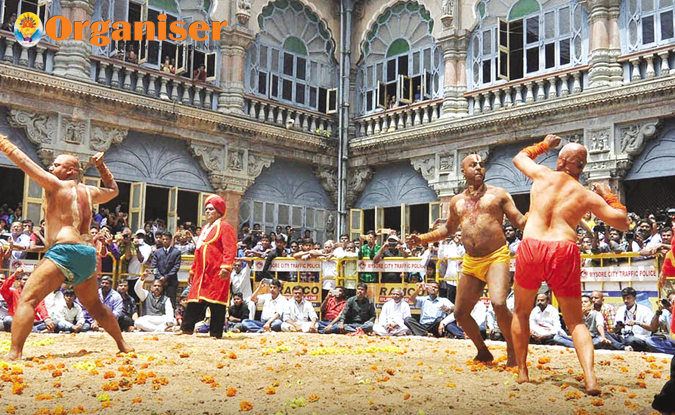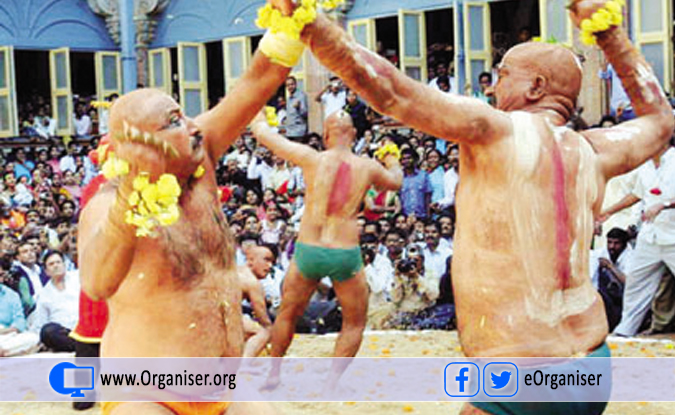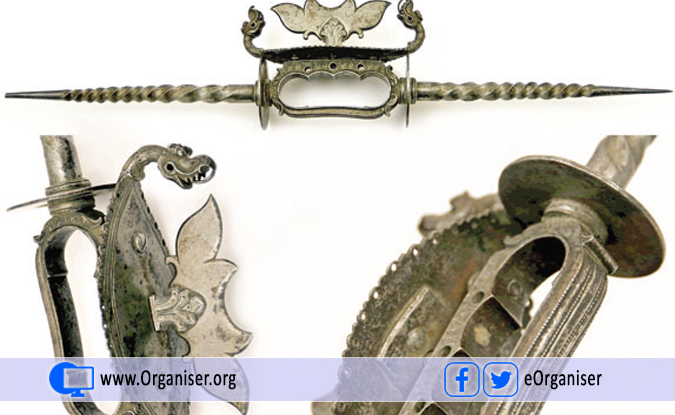The “fist fighting” is now reduced to a ritual to propitiate Goddess Durga. However, the gaming and competitive potentials are still high; awaiting a revival
‘Jattis’ participating in Vajramushti kalaga inside the palace courtyard to mark Vijayadashami in Mysore
Wrestling has been a traditional sport all across the Bharat for thousands of years. Various forms of wrestling have evolved in different parts of Bharat. In Karnataka and united Andhra Pradesh too, wrestling was a major sport patronised by the royal houses. Krishnadeva Raya of Vijayanagar is said to have been a practising wrestler. Ranadheera Kanteerava of the Mysore Wodeyar dynasty was also a great wrestler and patronised the sport in the kingdom.
Vajra Mushti Kalaga
A variation of Mushti Yuddha (fist combat) was Vajra Mushti Kalaga (Knuckle combat) where the two wrestlers would fight with metal knuckles of various shapes and sizes. Traditionally it is said that the fight would end with the death of the opponent. Historical records and inscriptions on temples at Belur and Halebidu showcase the practice of Vajra Mushti wrestling even during the reign of the Hoysalas. With the advent of Bahamanis in Hyderabad-Karnataka, the sport was restricted to Mysore region.
Origins and Continuity
Historical records trace Vajra Mushti to at least 1000 BCE. Siddartha Gautama is said to have been a practitioner of the same as per Buddhist records. Several Jain Puranas suggest that Bhagwan Bahubali was an expert in various forms of wrestling, including Mushti Yuddha.
Vaja Mushti Weapons
Dasara Kushti —Wrestling During Navaratri
Ever since Dasara was started in 1610 by the kings of Mysore, wrestling has been a regular feature of the 10-day festivities. The end of the Vajra Mushti signifies the beginning of the Dasara procession. Eight combatants battle out in Vajra Mushti bouts which are inaugurated by the scion of the royal Wodeyar dynasty every year. Combatants who participate in Vajra Mushti bouts were called Jetties. Wrestlers came from other parts of India too and mostly from Baroda but participate in Mushti Yuddha only. Vajra Mushti, Jatti Kalaga, Malla Yuddha, boxing, grappling, lifting round boulders are part of the festival. The Vajramushti Kalaga during Dasara comprises two bouts of wrestling featuring four wrestlers — one each from Mysore, Bangalore, Chamarajnagar and Channapatna.During Dasara, Vajramushti Kalaga wrestling contest was held in the courtyard of Mysore Palace in the presence of the King. Traditionally, Dasara used to end with the draw of first blood from one of the combatants participating in the duel and the world famous Dasara procession used to begin from the palace premises. Today a symbolic fight is organised before the start of the procession every year.
The traditional Mushti Yuddha involves the two opponents vying to attack the other’s pressure points in the body and render him unconscious. The detection of pressure points comes from Marma Shashtra or the science of energy points in the human body. Marma Shastra says that there are 108 ‘marma points’ in a human body and that prana or life flows through them. Exerting enormous pressure on one or many of these points will ensure that the prana ceases to flow and the person is rendered unconscious but can result in death too.
Revival and Patronage
However, with no state patronage, all forms of traditional Wrestling have slowly been dwindling and are less practised in the Garadis (wrestling houses) in and around Mysuru. There were about 250 Garadis in Mysore region alone in the 19th century which has dwindled to a handful few in Mysore, Hassan and Bengaluru. Once a popular sport in the old Mysuru region, wrestling finds no exposure beyond Dasara Wrestling Championship which is held every year during the Navaratri.
As part of the revival process, the State Government must open more garadis in several cities and encourage youngsters to join. Champions of various meets should be honoured by the government and must be given suitable jobs. Today, there is a need for concerned people to come together and plan to safeguard the sport for generations to come.

















Comments